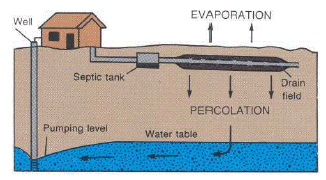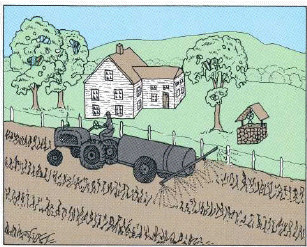Ground Water
Oil spills
Another chronic problem in many rural homes is leaking or spilled fuel oil
which eventually contaminates the owner's own well. Many homes have a fuel tank,
either buried or above ground, adjacent to the house and within a few feet of
the well. Spills or accumulated leakage eventually can migrate to the aquifer
and can be drawn into the well, making it unusable for years. Usually the only
solution is to obtain a new water source. In some instances, however, reducing
the pumping rate to reduce drawdown allows the oil to float on the water surface
safely above the well's intake area.
Methane gas
Perhaps the problem that poses the greatest hazard to a well owner is
flammable gas in the well. Small volumes of natural gas, usually methane, can be
carried along with the water into wells tapping carbonate or shale rock. In some
areas, the gas dissipates soon after installation of the well, but, in other
areas, a large continual source of natural gas remains. Because methane is
flammable and cannot be detected by smell, precautions are needed to prevent
explosions and fire. Venting of the well head to the open air is the simplest
precaution but, because gas can also accumulate in pump enclosures, pressure
tanks, and basements, other venting may be needed. For this reason, a home
should never be built over a well.
Bacteria
The most common water-quality problem in rural water supplies is bacterial
contamination from septic-tank effluent. A recent nationwide survey by the U.S.
Environmental Protection Agency and Cornell University found that contamination
of drinking water by septic effluent may be one of the foremost water-quality
problems in the Nation.
 |
| How septic effluent percolates to the water table. |
Barnyard runoff
Probably the second most serious water-contamination problem in rural farm
homes is from barnyard waste. If the barnyard is upslope from the well, barnyard
waste that infiltrates to the aquifer may reach the well. Pumping, too, can
cause migration of contaminants to the well. On many farmsteads built more than
100 years ago, the builders were careful to place the supply well upslope from
the barnyard. Unfortunately, many present-day owners have not remembered this
basic principle and have constructed a new house and well downslope of the
barnyard.
 |
| Barnyard upslope from farmhouse well may cause bacterial
contamination of water supply. (Photograph courtesy Cornell
University.) |
Pesticides and fertilizers
The last 3 decades have seen a significant increase in small part-time farms
and rural dwellings as large farms have been sold and divided into smaller
units. Many modern rural homes are constructed on former cropland on which heavy
applications of herbicides and fertilizers may have been made. How these
chemicals move through the soil and ground water and how quickly they decompose
or how their harmful effects are neutralized is not well understood.
 |
| New home on land recently used for crops. |
Also common is the farming practice of applying fertilizers and pesticides to
croplands immediately adjacent to the barnyard or farmyard. Residue from these
applications can infiltrate to the aquifer and can be drawn into a supply well
for the barn or the house. Decreasing the use of fertilizers and pesticides in
the vicinity of wells can help minimize this problem.
Homeowners also should be careful to properly dispose of wastewater from used
containers of toxic chemicals. Many farms have their own disposal sites,
commonly pits or a wooded area, for garbage and the boxes, sacks, bottles, cans,
and drums that contained chemicals. Unfortunately, these owner disposal sites
can contaminate farm water supplies.
 |
| Pesticide spraying near well. |
Septic Systems and Ground Water
The liquid effluent from a septic system follows the same path as the rain or
snowmelt that percolates into the unsaturated zone. Like the rain, once the
effluent reaches the water table, it flows down the hydraulic gradient, which
may be roughly parallel to the slope of the land, to lower points. Thus, again,
the location of one's house in relation to neighboring houses, both upslope and
downslope, is important.
Septic-tank effluent that enters the aquifer supplying the homeowner's well
introduces not only bacteria but also other contaminants. Many rural homeowners
also discharge other waste products, including toxic material, into their septic
systems, and these products gradually accumulate in the aquifer. What happens to
these contaminants in the ground is not well known. Some adhere to rock
material, others travel with the water. In some types of rock material, the
leach field or dry-well part of the septic system can gradually become clogged
by contaminants.
Rural homes in small, older communities and in more recent roadside housing
developments are commonly situated on small or narrow lots along an access
highway. Most do not have a community water supply, and almost all have their
own individual septic systems. In clusters such as this, effluent recycling can
occur if the wells are shallow or the septic systems are improperly placed. Deep
wells are less likely to draw in septic waste.
 |
| Rural roadside housing development. |
This type of effluent problem becomes acute in an area underlain by a shallow
water-table aquifer where the septic effluent discharges into water that is used
by many homeowners. This dilemma has been posed in many rural housing
developments throughout the Nation. One either "fouls his own nest" with
effluent or connects to a central sewer system. Although a sewer system protects
the aquifer from further contamination, it reduces recharge of water to the
aquifer. This engineering, economic, and social dilemma must be resolved soon in
many areas. An increasing number of counties and townships are planning and
zoning rural areas to limit the density of houses according to soil conditions.
Other approaches being considered are a community water supply with individual
septic systems or individual water supplies with a community sewer system.
Some banks and lenders require that the prospective buyer or the seller
furnish proof of a bacteria-free water supply before they will issue a mortgage.
When a seller faces such a requirement, a common procedure is to chlorinate the
water to destroy the bacteria in the well. This treatment affects only the well
and perhaps a volume of the aquifer immediately adjacent to the well, but for
only a brief time. If the contamination is in the aquifer, the source will not
be attacked nor the problem solved ; thus a water analysis showing bacteria-free
water immediately after the well has been disinfected is not necessarily an
assurance of a safe water supply. The homeowner should periodically have the
water analyzed for bacteria. If a high bacteria count occurs repeatedly, the
problem is probably in the water source, and chemical treatment of the well
alone cannot solve it.
In a bacteria-contaminated water system, chlorination of the water pumped
from the well is commonly recommended as a solution. Other-wise, one must obtain
a water supply from a new well that either is upgradient from the contaminating
source or that taps a deeper aquifer. Moving the septic system to a more distant
spot is a long-term solution, but the underlying contaminated zone may take
years to stop releasing contaminants to the aquifer.
Cluster-housing contamination
In a row-housing setting, the house at the highest location will generally
have the safer water supply. Because the effluent migrates down beneath the
development, it could be pumped, used, and again discharged by each house along
its course. The house furthest downslope would receive the combined effluent
from the other houses.
Another contamination problem from closely spaced septic systems can occur
where a row of houses on the uphill side of a road faces a row of houses on the
downhill side of the road. Here, the safer water supply would be on the uphill
side. The downhill side would receive effluent from the uphill side plus any
contamination generated along the road, such as road salt or metal compounds. In
flat areas underlain by a shallow water table, especially where cluster
developments are two or more decades old, almost perpetual recycling of septic
waste may occur.
Another source of contamination that is common in villages or hamlets lacking
a central water or sewage system is small waste-generating businesses such as
laundries, auto-repair shops, and industries that discharge wastes to their own
septic systems. Many of the bacterial problems, cited in a recent U.S.
Environmental Protection Agency rural water study, were in hamlets, villages, or
crossroads communities. Once indoor plumbing became common and outdoor privies
were removed, all waste went into septic systems from which increased amounts of
liquid effluent eventually entered the aquifer and became subject to pumping by
wells.
Unknown Hazards Beneath the Land
Previous land uses, some of which may be unknown to the present landowner,
can have long-lasting effects on the land and on underlying aquifers.
 |
| Hidden dump site may contain chemical-waste containers. |
Former chemical dump sites
Many sites where commercial and industrial wastes are buried have been
abandoned and have been covered with soil or have become revegetated. In many
such areas, individual homes or entire housing developments have been built
without proper consideration of the buried waste. (The tragedy of Love Canal,
near Niagara Falls, N.Y., is an unfortunate example of construction over
concealed waste.) A prospective land buyer, home builder, or buyer of a recently
built rural home should inquire of local agencies about the former use of the
land.
Abandoned wells
Although still relatively rare, waste sites can be abandoned wells that are
now used for disposal of wastes, commonly oil or laundry wastes. Many garages
and repair shops have used abandoned drilled wells for disposal of waste oil,
and laun-dries have used abandoned dug wells for disposal of laundry wastes to
prevent clogging of their septic systems. These practices point to an area where
concern for ground-water protection should be considered more carefully.
Abandoned wells should be filled and sealed properly to eliminate the danger of
someone falling into the well or having the shaft collapse, as well as to remove
the temptation to use them for disposal of hazardous wastes.
|

